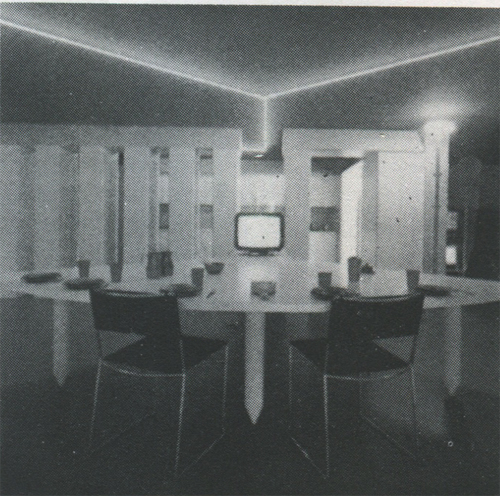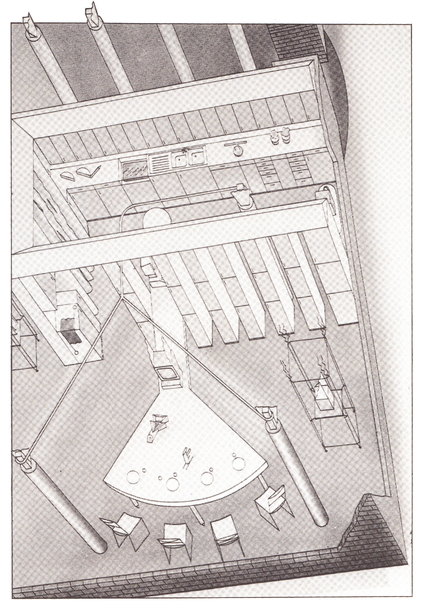La Casa Elettrica
Who doesn't know the annoyance caused by a badly organized house, due either to the lack of a good housekeeper or by the hard work a good housewife must put in to make the house comfortable at every time of day? Only machines can save everybody from this kind of slavery ...1) Thus begins an article in The Edison Review (1930) about La Casa Elettrica, a house filled with electrical apparatus.
La Casa Elettrica was a villa built for the Triennale in Monza (Italy) by rationalistic architects in 1930. The clever arrangement of the rooms and the efficient position of the electrical apparatus in the house had to provide a notable relief from domestical duties. In the future everyone, irrespective of social class, was to live in such a house.
Ugo La Pietra's cotroversial design can be regarded as a reaction to the object-focused culture of which La Casa Elettrica marked the beginning.
La Casa Telematica
From a house filled with electrical apparatus to the electronic household is just a small step. La Pietra designed such a house, conceived as an installation, at The International Fair in Milan (1983). La Case Telematica consists of a living-room and a kitchen. The former is almost completely filled by a triangular table ending in a board which leads into the kitchen. Opposite this board are four chairs side by side. A TV-set adorns the table facing the chairs so that everyone can enjoy the programs while having dinner. But the pleasures of watching television are not restricted to dinner time. While the cook chooses today's recipe from the culinary database of the kitchen computer, the others play their favorite video game or watch an exciting movie. Monitors and terminals are everywhere, allowing the whole family to make their choice from the programs offered.
A house filled with electrical apparatus and a house filled with electronics. Both expressions of technology. Both intend to show new habits in domestic life. But the former is meant to be a dream of the future, the latter a model of/for comprehension of the daily environmental reality.2)
The TV-chair
La Pietra's TV-chairs (1982) are another comment upon the influence of audiovisual apparatus on our daily life and rituals. These chairs have a TV-set in their backside. They are no longer placed in the room facing each other, but in a row. Sitting behind each other, all the members of the family watch their favorite TV-program. To make sure that no one is bothered by the others, the chairs are equipped with headphones. No more quarreling over the programs. In fact more quarreling at all.
Counterdesign
Since the late sixties, La Pietra has been theorizing about the social function of design in everyday life. He belongs to the generation of designers who in the sixties expressed their disapproval of the role, industrial design plays in the consumer society. According to them design had become an aesthetic phenomenon, a consumer article meant only to please the user, reassure him and consolidate his social status. The counter- (anti- or radical) design movement of which La Pietra was a representative, tried to dramatize this situation by using all kinds of expressive means in order to demystify design. They were looking for new principles.
Sistema disequilibrante
At the time Ugo La Pietra developed his theory about Sistema disequilibrante (unbalancing system). This theory states that the designer who want to contribute to structural changes in society, must emphasize those forms that correspond to the subversive logic of the productivity-oriented system.3) Starting from this strategy he presented some models that should make the consumer aware of the influence the environment has on his behavior. The first model Immersione, immersion, is a kind of container. The spectator can enter it so that, temporarely, the inside of the container is the only perceptible environment. A metaphor of the inescapable daily reality. The second model La nuova Prospettiva, the new perspective, is a variation on a 17th century camera obscura. Lens and mirror are removed so the user sees reality as it is. The spectator has to be satisfied with his personal view on reality without being able to rely on the "objective" choice of others, presented to him through the media. The third model Ambiente Micro, the micro environment, is a neutral cell equipped with various communication installations of which the object - quality has been reduced to that of an ordinary faucet. The occupant of this cell can communicate with any place in public space and can be reached by everybody, making the cell a symbol for free, democratic, undirected communication.
La Case Telematica and the TV-chair can be seen as a continuation of La Pietra's models from the six-andseventies, as his intention is still to confront the public with the influence of the environment on behavior. The symbolic alternatives, however, have given way to metaphors of daily practice; the tone has become slightly more resigned.
La Pietra's work approximates reality more and more. Some of his caricatures have in fact been produced already by others. We've come full circle.
1) Leonardo Benevolo The beginning of modern research, 1930-1940, in: Italy: The New Domestic Landscape, The Museum of Modern Art, New York 1972, p.313
2) cat. tent. Phoenix/New Attitudes in Design, Toronto, Canada 1984, p.46
3) Ugo La Pietra The Domicile Cell: A Microstructure within the information and communications systems, in: Italy: The New Domestic Landscape, The Museum of Modern Art, New York 1972, p.227
If you'd like to quote something: Possel, Jans. "Media/Rituals/Design." Mediamatic Magazine vol. 0 # 0 (1985).
Translation: Barbara Groenhart

